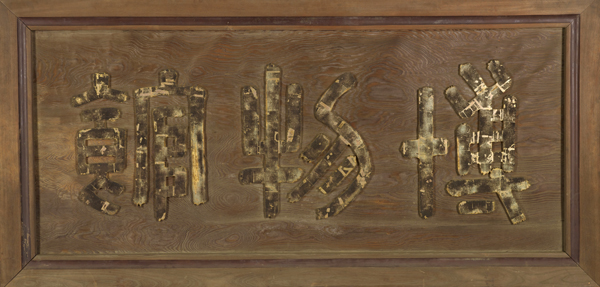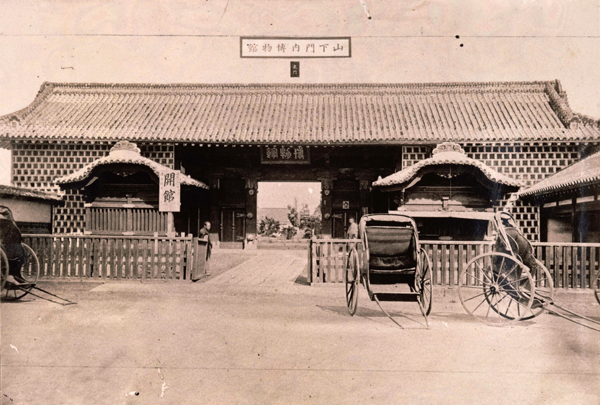5.Yamashitamon-nai Museum : The Museum under the Home Ministry

Calligraphy "Hakubutsukan" by MACHIDA Hisanari that adorned the museum gate
In March 1873, the Museum was incorporated with the Exposition Bureau and Shojakukan, together with other facilities, and was transferred to Uchiyamashita-cho. The Museum stood there until it moved to Ueno Park in 1881. It had seven exhibition buildings for antiques, animals, plants, minerals, agriculture and foreign items. There was also a place to raise animals, a room for bears, and a greenhouse.
Soon after its move, the Museum held an exhibition that was to last for two months starting from April 15. The exhibits included works that were left over from those chosen for the World's Fair in Vienna and works from the museum collection, as well as the collections of various noble families. The works included bronze bell-shaped vessels, bronze pikes, golden shachi figures for rooftops, microscopes, and Western playing cards. The exhibition was well received and in the end, the period was extended to three and a half months. After the exhibition, the museum was opened every month on days ending in 1 or 6. An exhibition was also held in 1874 which featured antiques, experimental apparatus for physics and chemistry, and medical items, among other objects. That same year, an exhibition of old and new paintings and calligraphic works was held at the Taiseiden Hall of the former Yushima Seido. On March 30, 1875, the Exposition Bureau was placed under the authority of the Home Ministry and was changed its name to "Hakubutsukan", or "Museum". The organization subsequently changed its name to the "Sixth Bureau of the Home Ministry", the "Museum", and finally to the "Museum of the Museum Bureau".
Uchiyamashita-cho, where the museum was located, is the present Uchisaiwai-cho 1-chome in Chiyoda Ward, where we find the Imperial Hotel, headquarters of the Mizuho Bank and Nippon Telegraph and Telephone East Corporation today. During the Edo Period, the shozoku residence of the Satsuma clan, where the visiting samurai changed their costumes, and the main residences of the Iiyama and Ogi clans stood there. The place name of Uchiyamashita was created in 1872 since the area was situated inside the moat facing Yamashita-cho, in other words, inside the Yamashita gate. In 1883 the Rokumeikan, a hall where Japanese and foreigners socialized, was built in the area. It was turned into a meeting place for the nobility in 1890. The Imperial Hotel was opened nearby in 1887.

Front Gate of the Yamashitamon-nai Museum
 |
 |
|||
